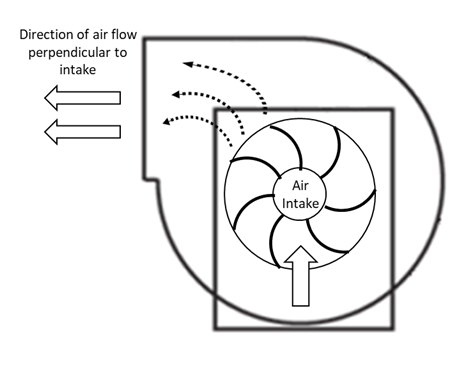Ventilation
25 Centrifugal Fan
Click play on the following audio player to listen along as you read this section.
https://video.bccampus.ca/id/0_doijnfsp?width=608&height=70&playerId=23448552
Centrifugal fans are better suited to push larger volumes of air through ducting systems. They are designed to produce higher pressure for a given volume of air than an axial fan of the same horsepower rating. Any fan used to drive air throughout the system must produce enough total pressure to overcome the static pressure of the ducting system and drive air everywhere it is needed.

Drawing the intake air at 90 degrees relative to the outtake, the fan blades direct the air in an spinning, circular direction, accelerating it towards the exhaust vent.
Depending upon the application, the drive mechanism of the fan may be directly coupled, belt driven, or powered by a variable speed drive.
Centrifugal fans are noisier than an axial fan of equivalent horsepower, and so are often installed in areas where high noise levels are acceptable or noise dampening components can be installed.
Centrifugal fans can move large quantities of air, while overcoming all the resistive static pressure of the duct-work system.
Axial fans drive low volumes of air under low static pressure conditions in parallel with their axis of rotation. Mainly used for cooling of coils.
The sum of static and velocity pressure that must be overcome by an air handling unit.
The force resisting the movement of air.
A centrifugal fan drives lager volumes of air under high static pressure conditions at a right angle to its axis of rotation. Mainly used for the moving air through ductwork.

